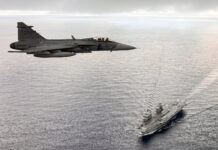
Attritable Aircraft
Sidney Dean
Armed forces on both sides of the Atlantic – and beyond – plan to add attritable aircraft to their fleets. “Attritable” is a reference to attrition warfare, and should not be equated with “disposable.” Rather, armed forces are seeking to acquire sophisticated unmanned aircraft which can be deployed numerous times, and preferably never be shot down.
By increasing the number of combat aircraft in the fleet, it becomes possible to sustain losses while maintaining combat power. The loss of attritable aircraft is acceptable if it contributes sufficiently to a tactical or strategic objective. The primary consideration determining the acceptability of the loss is whether the operator or the adversary gains the greater advantage through the exchange. For example, the loss of a highly sophisticated Unmanned Aerial System (UAS) might be considered an acceptable price if the mission eliminates an enemy air-defence node, thereby enabling follow-on forces to inflict significant damage to the enemy.
To be considered “attritable”, however, the planes must be produced at considerably lower cost than manned aircraft, and in sufficient numbers to ensure a continued operational capability after the loss of several units. A September 2020 paper by the Mitchell Institute (US Air Force Association) predicted costs between US$2M and US$20M per aircraft, depending on sophistication and capabilities. The same study estimated that manufacturing an individual UAS might take weeks, rather than the 18 months required for a manned combat aircraft, making it easy to scale up production on short notice.
While attritable aircraft are by definition unmanned, the term is not synonymous with UAS. Some highly sophisticated unmanned aircraft – including large, high-performance combat aircraft such as BAE’s TARANIS concept – will be too expensive and too capable to be classified as attritable; with exception of the human crew, the loss of such expensive high-performance planes would be every bit as damaging as the loss of a manned aircraft. On the other hand, the majority of currently operational UASs – while expendable – lack the sophistication and operational capability demanded of the aircraft being designed for the “attritable” category.
Capabilities and Operational Concept
Highly advanced Artificial Intelligence (AI) is a prerequisite for fielding attritable aircraft. Command and Control will include a combination of autonomous operations and remote control, either from a ground station or from a manned aircraft (Manned-unManned Teaming or MuMT). Experiments conducted by USAF’s Air Force research Laboratory (AFRL) concluded that a single human can safely control up to seven UAS if these are equipped with adequate AI.
The capabilities profile of the objective aircraft will be similar to that of manned aircraft, which classifies them as Unmanned Combat Air Vehicles or UCAVs. In order to keep up with manned combat aircraft, they will be equipped with jet engines. Most designs feature low
observable/signature reduction attributes to enhance tactical advantage and survivability. The mission profile will be geared toward sophisticated applications including Intelligence, Surveillance and Reconnaissance (ISR), strike and Electronic Warfare (EW). They will most likely be flown in direct support of manned aircraft, acting as force multipliers. The primary impetus for developing attritable aircraft is in fact the likelihood that sophisticated opponents will have powerful Integrated Air Defence Systems (IADS) consisting of multiple layers of sensors, ground based interceptors and interceptor aircraft. Attritable aircraft will increase the number of offensive platforms, enhancing offensive capability while simultaneously taxing the enemy’s IADS. These aircraft might conduct particularly high-risk segments of a mission, such as suppressing or destroying enemy air defences, temporarily blinding them via EW, or drawing enemy air-defence fire to reveal the location of opposing force launchers. In a similar vein, UAS can detect enemy aircraft or lure them into kill zones. Several nations have dubbed their fixed-wing combat MuMT projects as “LOYAL WINGMAN” programmes.
USAF SKYBORG
The United States Air Force (USAF) LOYAL WINGMAN programme has been redesignated as SKYBORG. USAF awarded prototype development contracts to several firms in 2020. Payload options will include air-to-ground weapons, electronic warfare suites, communications relays, and a variety of sensors. These UCAVs will also be able to carry and deploy smaller UASs as reconnaissance assets or as loitering munitions. USAF plans to fly the first prototype in 2023. Like other LOYAL WINGMAN concepts, SKYBORG is primarily intended to fly joint missions together with manned aircraft, including the F-22, F-35, or future manned combat aircraft models. The crew of the manned plane would most likely maintain operational control over the UAS, especially as the flight approaches its objective. This control would take the form of issuing commands and directives (including weapons release), with the UAS’ AI independently executing the commands and retaining control over flight manoeuvres. Missions could include Suppression of Enemy Air Defence (SEAD) or destruction of other enemy targets. Other applications could include EW, triggering enemy air defences which would then be targeted by the manned aircraft, or detecting ground targets for manned aircraft. In the latter role, sending the unmanned wingman into the enemy air defence zone would permit manned aircraft to remain at a safer distance, and fire stand-off weapons at the detected targets.
According to Douglas Meador, deputy programme manager of the AFRL’s Low-Cost Attritable Aircraft Technology programme, the term “LOYAL WINGMAN” can be misleading. “It gives the impression these aircraft are going to be flying close together [but] in many concepts … these aircraft won’t be in visual range of each other,” Meador told Air Force Magazine in September 2020.
Operational concepts and requirements are still being refined. The Air Force Warfighting Integration Capability study group (AFWIC) has considered the feasability of establishing five to ten squadrons of low cost attritable aircraft, according to Colonel Frederick Haley, deputy director of AFWIC’s futures and concepts division. An alternative under consideration would be integrating the UAS into F-35 squadrons, with two unmanned aircraft per manned plane, Haley told Air Force Magazine.
BAE Systems
BAE Systems was awarded a US$400M contract in October 2020, somewhat later than other firms, to develop a UCAV prototype. Drawing on two decades of autonomous system development, BAE announced that it would equip its prototype with in-house mission management and control systems, sensors and payloads.
Boeing
Boeing has already contracted with the Royal Australian Air Force (RAAF) to develop that service’s LOYAL WINGMAN system, also known as the Airpower Teaming System or ATS. While the aircraft resembles the MQ-25 autonomous UAS which Boeing is developing as a carrier-based tanker for the US Navy, the firm describes the RAAF LOYAL WINGMAN as a “clean-sheet” design. The ATS is currently undergoing flight tests in Australia. Current RAAF planning calls for deploying the ATS for ISR and target acquisition.
Boeing has announced that it will base its SKYBORG prototype on the 11.7-metre long ATS. Performance characteristics include a 2,000 nm range and “fighter-like” manoeuvrability. A core feature is the 2.6-metre long modular nosecone, which can be adapted to various sensor payloads. The nosecone can be exchanged quickly, permitting preconfigured payloads to be kept ready at operational airfields. Unofficial estimates of the unit cost place the ATS in the competitive US$2M to US$3M range.
General Atomics
General Atomics – Aeronautical Systems Inc. (GA-ASI) is using two of its remotely piloted AVENGER UAS as testbeds for SKYBORG technology and concepts. The AVENGERs are being provided with upgraded datalinks and the core SKYBORG System Design Agent (SDA) software which will enable manned aircraft rather than a ground station to control the UAS. The jet-powered AVENGER has a 20-hour flight endurance and a 15,000-metre service ceiling. GA-ASI states that it can be configured to carry air-to-ground weapons as well as small UAS (sUAS) as payload. These sUAS could be released at standoff range to conduct ISR and targeting for the larger unmanned aircraft. The experimental flights will take place through 2022.
Kratos
Kratos is basing its submission on the XQ-58A VALKYRIE UAS, which USAF has been testing since before the inception of the SKYBORG programme. The 9.3-metre long VALKYRIE’s performance features include a cruise speed of .72 Mach, a 3,000 nm range, and a 20,000-metre surface ceiling. The internal payload bay can carry a 270 kg payload; the same payload can be carried externally under the wings. On 26 March, a XQ-58A released a multi-purpose 3.5 kg ALTIUS 600 sUAS, demonstrating the capacity to operationally deploy individual or multiple (swarming) drones from the UCAV. The VALKYRIE has also been deployed as a tactical communications link together with mixed flights consisting of F-22s and F-35s; during these tests the UAS permitted the two manned aircraft types, whose data systems are not directly compatible, to communicate.
Like several other UCAS models, the VALKYRIE is highly modular. According to Kratos, most major elements of the plane, including the nose, the wings and the wings’ leading edges can be exchanged to meet individual mission requirements. In 2019, Kratos estimated unit costs of US$2M per VALKYRIE UAS, or roughly twice as much as a cruise missile. This estimate was based on a procurement contract for 100 units. The price per plane does not reflect the cost of sensors or other payloads.
SKYBORG AI
While the UAS fuselage and payload packages will be critical to mission performance, the true key to success lies with the SKYBORG AI system being developed by the AFRL. The software suite which will enable autonomous flight as well as flawless response to external input is formally designated as the SKYBORG Autonomy Core System or ACS. The first ACS flight test was performed on 5 May 2021. For this test, the software was loaded aboard a Kratos UTAP-22 MAKO, a 6-metre long UCAV previously developed for LOYAL WINGMAN applications. The test flight lasted 130 minutes and was deemed a success. The accompanying USAF press release stated that “the ACS demonstrated basic aviation capabilities and responded to navigational commands, while reacting to geo-fences, adhering to aircraft flight envelopes, and demonstrating coordinated manoeuvring.”
The 5 May flight was designated as Milestone 1 of the Autonomous Attritable Aircraft Experimentation (AAAx) programme. “We’re extremely excited for the successful flight of an early version of the ’brain‘ of the SKYBORG system. It is the first step in a marathon of progressive growth for SKYBORG technology,” said SKYBORG Programme Executive Officer (PEO) Brigadier General Dale White. Milestone 1 was the first in a series of ACS experiments planned over the next several months. The AFRL plans to demonstrate direct manned and unmanned teaming between aircraft and multiple ACS-controlled unmanned aircraft during these tests.
European Programmes
Comparable programmes are being pursued in Europe.
RAF LOYAL WINGMAN
The British Royal Air Force (RAF) LOYAL WINGMAN programme is also known as Project MOSQUITO. This project devolved out of the RAF’s overarching Lightweight Affordable Novel Combat Aircraft (LANCA) concept initiated in 2015. LANCA sought to enhance combat mass and force resilience by developing UCAVs capable of MuMT or autonomous/unmanned swarm operations.
A phase 2 Project MOSQUITO contract was awarded in April to an international group including Spirit AeroSystems Belfast (airframe and lead contractor), Northrop Grumman UK (AI, networking, human-machine interface), and Intrepid Minds (avionics and power). The attritable MOSQUITO UCAV will be deployed alongside the RAF’s F-35, TYPHOON and next-generation TEMPEST manned fighters to enhance protection, survivability and information advantage to aircrews. According to the British MoD, the lightweight, composite-hull UCAV’s internal payload bay will accommodate air-to-ground and air-to-air weapons; the UCAV will be able to engage aerial targets including enemy combat aircraft and air-to-air missiles. Full-scale prototype flight is planned for 2023.
FCAS
The Franco-German Future Combat Air System (FCAS) being developed by Airbus and Dassault will include the manned Next Generation Fighter (NGF) as well as UCAVs designated as Remote Carriers (RC). NGF and UCAVs will be fully networked, and will jointly constitute the Next Generation Weapon System (NGWS).The RC will be produced in various size classes, from expendable air vehicles weighing only a few hundred kilos, to more sophisticated LOYAL WINGMAN aircraft weighing several tons. Modular payloads will support missions ranging from ISR and target acquisition to EW strike, kinetic strike, and air-to-air combat. Operational models include swarm attacks by RC aircraft, including flights involving various types of RC.
Unlike USAF’s SKYBORG programme, which is developing UCAVs to join the existing air fleet, FCAS is being developed from the start as a unified system encompassing manned and unmanned elements. While this should facilitate the seamless integration of NGF and RCs, it also means that the full system will be fielded later than the US or British attritable UCAVs. According to Airbus, the current planning calls for introducing MuMT between upgraded existing fighters such as the Eurofighter LTE and first-generation RCs in the early 2030s. The full FCAS vision – with the NGWS as its core – is expected to be operational by 2040.
This article originally appeared in the July issue of European Security & Defence. Click here to download the full issue in PDF format.












